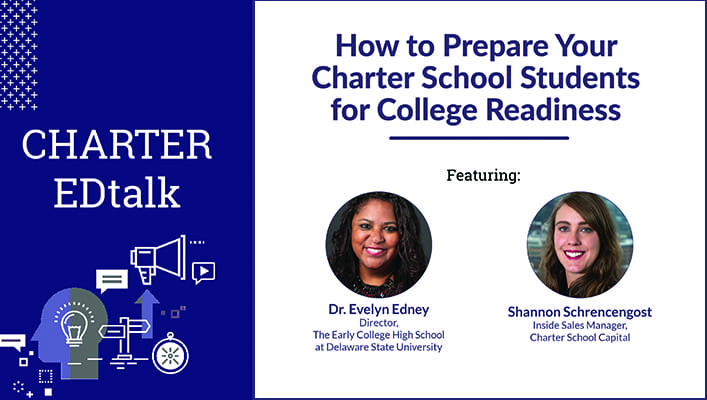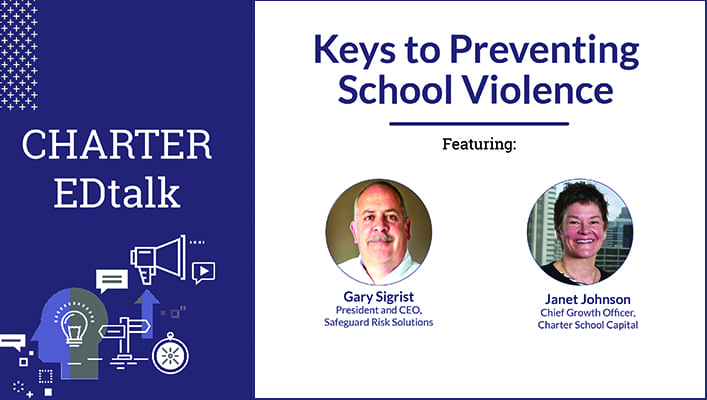CHARTER EDtalk: How to Prepare Your Charter School Students for College Readiness
In this CHARTER EDtalk, Charter School Capital Inside Sales Manager, Shannon Schrencengost had the pleasure of sitting down with Director of The Early College High School at Delaware State University, Evelyn Edney, to discuss how their school’s curriculum, programs, and staff help underrepresented charter school students become college-ready. Watch the video and read the complete transcript below to hear the whole story.
Shannon Schrencengost: Hi, I’m Shannon Schrencengost with Charter School Capital, and I’m here today with Evelyn Edney from the Early College High School in Delaware. We’re going to be chatting a bit about college readiness. So Evelyn, tell me little bit about what Early College High School is doing to measure college readiness.
Evelyn Edney: So, we are a very small charter school, and we are affiliated with Delaware State University. The whole premise of our school is to allow underrepresented youth to have kind of get a leg up and be able to start taking college classes while they’re in high school. So, we needed to come up with a way to determine who gets to take the college classes and when, because we want to make sure that they’re ready. Most tools out there are always looking at things like just SAT scores, or just this. And I created a tool that allows us to look at the whole student to be able to gauge how well they’re doing and to give students points to say, “Hey, here’s where I can improve.” And that sort of thing.
So, our college readiness rubric measures the categories that we thought went into college readiness. Of course grades. We need to see that our students are able to do college level work. Their attendance, because college professors care if you show up. And we look at their behavior. If you’re a student who knows that I have a bathroom in my office, you’ve been in there too many times, and maybe you’re not quite ready to be sitting in a college classroom taking college classes just yet. And we look at how well students do on bigger assessments. We have some school level assessments, we have some common assessments through grade levels, we have some state level assessments. And so, we look at those assessments in conjunction with the other things. And then we also ask our teachers to recommend the students. So, those are the five factors that kind of go into our college readiness rubric.
Now, it sounds like we’re just looking to measure the college readiness, and we are, it works in our particular situation, but this tool can be something that anybody could tweak and then make it their own to measure something that may be a priority in their schools.
Schrecengost: What personally motivates you in working with the school that has a mission and vision college readiness and the college going mindset?
Edney: Well, growing up I would have been one of those underrepresented students, and had I not had some educators in the school that I was in work with me to be able to get to a point where I could do college level work and to help me actually get there, I don’t think I would have made it and I might be a different kind of statistic right now than the one that I am. So, that personal story keeps me motivated to want to help other students who may be in the same boat.
Schrecengost: I’d love to hear some kind of success stories. Students who’ve gone on to college and what they’re doing now.
Edney: Well, our school is small and it did just start a few years ago. So, we just graduated our first class, the class of 2018 last year. And the valedictorian went to Stanford on a free ride. The salutatorian went to University of Pennsylvania on a free ride. And a lot of the other students went to other smatterings of school, but the majority of them went to Delaware State University, the school who started at all with us. And so, that makes me excited to now see the students on campus. When I was their high school principal, they tried to run from me when they saw me on campus, but now they’re freshmen in college, but with credits. A lot of those students started at Delaware State University as a first year student, but they’re coming in with almost over a year and some of them up to two years worth of college credits under their belts to kind of keep them going. And so, that’s exciting to us.
Schrecengost: That’s very exciting. I think, there’s a lot of national conversation around college debt right now. So, thinking of the savings for those students, I’m jealous. I wish I had done a program like that when I was in high school, so that’s really neat.
Edney: A lot of adults say the same things. A lot of the parents of these students, they get it. Not all of the students are all wanting and willing to go to an early college program. I think some of their parents kind of drag them by the ear, but because they know what the opportunity involves. And our partner at Delaware State University is phenomenal. I mean we would not be able to do what we do. They literally provide a building for us to be in tuition free for our students. This high school pays for the student’s books, and so this whole track for our students, it’s free. And so, it really helps them get that leg up, and most of them are going to graduate from college in literally a year, almost two years earlier than their peers in other schools.
Schrecengost: I know there’s a significant amount of work that goes into building a charter school. What did that feel like for you when you saw that first round of graduates walk across that stage?
Edney: That was an exciting moment for me. I was very excited, and our legislators are very, very supportive. Our Congresswoman Lisa Blunt Rochester was our keynote speaker that evening, and Senator Carper, Thomas Carper, he came up through a monsoon in Washington and they weren’t in session just to attend to our graduation. And so, that made us kind of excited that we had people who were supporting us. And it is hard.
You must have that kind of support in going through, and again and I mentioned Delaware State University as being a partner, they’re not only a partner in things like the tuition or the building they provide us, but their professors will create opportunities for our students to kind of experience going into their labs and working alongside of real college students to be able to show students another side of things that they would want to kind of pursue.
Schrecengost: What do you think other charters who might want to start doing dual college programming, want to implement that, what advice do you have for them?
Edney: To sit down and look at what factors they believe go into college readiness, and figure out a way to put that onus on the students and give them a tool that helps them measure where they are, and set goals on where they want to be so that they can do well in a program like ours.
Schrecengost: All right, everyone. How do you ensure that you’re meeting the needs of all students to ensure that they’re college ready?
Edney: Well, the way our rubric works, it measures the student’s college readiness eight times a year so that it coincides with grade reporting. When we get back these really great reports that we use, working through Performance Plus Power School, we are able to look at the rubric and the report and on it we can kind of see the student’s score. And if it’s at a score that kind of deems them not quite college ready, but more at potential, we look at what the factors are and based off of their score, we kind of create a system of supporting the student.
One layer could be for the students who are most needy, I usually will personally meet with them or my assistant principal. We sit down, have a meeting with myself, the school counselor, that parent, that student and we map out kind of a plan of success. Whether we put supports in place like get them a tutor, have them use resources at the college that we’re affiliated with. We also have an after school extra help program, but we put supports in place around the subject area or the factors that they need help in the most. And then we try to map out that plan and then we check on it periodically to see that they’re doing. A student’s score may yield that they meet with their advisor. Each student has an advisor and that advisor advisee relationship’s really important in our school. And so they sit with them and meet with them and do kind of the same thing that we’re doing, but it’s kind of done with their advisor.
We use that to kind of put those supports in place so that those students can reach that and be able to do the college courses.
Schrecengost: Got it. And tell me about your relationship with key community stakeholders and ensuring that they’re bought into the college going vision.
Edney: It’s not hard to sell it because a lot of businesses as well as our immediate school stakeholders, like our parents are very involved. We try to streamline this whole college readiness program in everything that we do. For instance, our positive behavior support program, horn at pride, catch it. That’s a big thing. If you walk up to one of my students and say that, they will say that back to you. But we take that and we look for a way the students who are deemed college ready, we want to make sure even though we have a plan to put in place for those students who don’t quite make it each time that we’re doing, for the students who do, we want to celebrate it.
We try to do some celebrations every single month to celebrate the students who are there. And the PTSA will sponsor one or two. They sponsored a skating party or we get stakeholders in the community to maybe sponsor a, what we would call dinner and a movie and we would show movie at school and they sponsor a dinner there. Or we take the students to the movies and so forth. We try to bring the community in that way. We also create field trips that are educationally sound, and so the students may be able to go to one of the field trips that are sponsored by the university and community members.
Schrecengost: That’s great. It sounds like you have a lot of support and that’s fantastic.
Edney: We do. It’s really great.
Schrecengost: Awesome. What am I not asking that you want people to know about your school?
Edney: It’s great. I love going there every single day. It’s been wonderful and hard at the same time. Everyone knows in little tiny charter schools you all have to wear a million hats, and I am lucky enough to have a staff who really believes in our model, and that they will go over to our wall of invisible hats and grab whatever one’s needed to make sure that these students are succeeding. And really trying to work, let that be our mission every single day.
Schrecengost: Thank you Evelyn. I appreciate you taking the time with me.
Edney: Thank you.
 Since the company’s inception in 2007, Charter School Capital has been committed to the success of charter schools. We help schools access, leverage, and sustain the resources charter schools need to thrive, allowing them to focus on what matters most – educating students. Our depth of experience working with charter school leaders and our knowledge of how to address charter school financial and operational needs have allowed us to provide over $1.8 billion in support of 600 charter schools that have educated over 1,027,000 students across the country. For more information on how we can support your charter school, contact us. We’d love to work with you!
Since the company’s inception in 2007, Charter School Capital has been committed to the success of charter schools. We help schools access, leverage, and sustain the resources charter schools need to thrive, allowing them to focus on what matters most – educating students. Our depth of experience working with charter school leaders and our knowledge of how to address charter school financial and operational needs have allowed us to provide over $1.8 billion in support of 600 charter schools that have educated over 1,027,000 students across the country. For more information on how we can support your charter school, contact us. We’d love to work with you!







